This is what park roses look like.
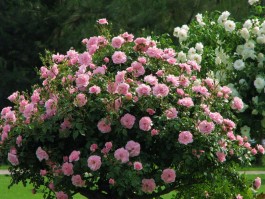 |
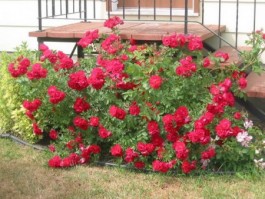 |
Park roses - this name is firmly attached to cultivated rose hips - their species, forms and varieties. There are several independent groups of park roses: wild roses themselves, among which are the famous wrinkled rose, ancient garden (park) roses, as well as modern breeding hybrids.
Abundant flowering begins in late May - early June, 2-3 weeks earlier than all other roses, and lasts more than 1 month.The color of the flowers varies from white to dark purple, sometimes orange and yellow are found. Planting and caring for park roses is distinguished by its simplicity, since these plants are not whimsical and not demanding.
Breeders have achieved excellent results, and modern hybrids are no less spectacular than polyanthus or floribunda, they grow well, are easy to care for and are covered with fragrant flowers of varying degrees of terry for 1.5-2 months. And in terms of the richness of their color range, they have long been close to hybrid tea roses.
Canadian park roses
Canadian park roses were invented specifically for the masses of people, since their care is minimal, and therefore, accordingly, they are easy to grow. They do not require pruning, are extremely winter-hardy, and tolerate weather conditions such as heat and severe frosts.
From the very beginning, this “new” among park varieties was conceived by Canadian scientists to withstand the harsh winter that is typical of their climate. This species can survive at temperatures as low as -35 °C, even at -45 °C.
Canadian roses look great not only in compositions, but also as individual bushes. They can be planted almost anywhere. They bloom in two waves, with the second wave, as usual, being less abundant. Some do not remove faded shoots, as a result of which the bushes end up strewn with numerous fruits, which also looks quite decorative in the fall.
Below are the varieties of Canadian park roses.
English park roses
English park roses come in different forms: bush and climbing. The exclusivity of this type lies in the highly double flower (more than 100 petals) and a wide range of scents.They are distinguished by exquisite cascading branches covered with dense pom-pom-like buds. They are planted both in partial shade and in the sun.
Caring for such roses is not difficult, but not as simple as caring for their Canadian relatives. Among the disadvantages of this type is susceptibility to diseases and pests, average resistance to frost. English park roses must be covered for the winter.
Planting park roses
Where is the best place to plant? The principles of choosing a location and planting for all park roses are the same, especially since they are drought-resistant and undemanding to soil. Most species are photophilous, grow well in moderately moist loamy soils, and do not tolerate waterlogging. They are used for planting in groups or individually in parks and gardens, for decorating fences, walls, and combined plantings with other shrubs and ornamental plants.
Among park roses, single-flowering roses predominate; in recent years, varieties of remontant, multiple-flowering roses have been developed. Due to the fact that many varieties are bred on the basis of hardy wild rose hips, they bloom profusely with minimal care. Such roses are distinguished by their undemanding conditions for planting and growing, and do not require complex agricultural technology.
Landing. It should be noted that those planted in the fall, before the first frost arrives (until mid-October), park rose bushes will have time to take root, and therefore will develop better and outpace those plants of this class that were planted in the spring. Plants are placed at a distance of 1.5 m from each other according to a 3.0 x 1.5 m pattern.When creating a high hedge, the planting density in the rows is 50-100 cm, between the rows - 50-70 cm.
Before planting, organic and mineral fertilizers are applied. The above-ground part is cut off, leaving no more than 1/3 of the length of the shoots. The planting hole should be large enough for the roots to lie down (not bend upward), and the grafting site (root collar) should be 5-10 cm under the soil. After planting, roses are hilled up to a height of 25 cm. In spring, the soil is leveled. The soil under the bushes and between them is mulched with peat and straw crumbs.
Caring for park roses
Due to the unpretentiousness of this group of roses, minimal care is required. They practically do not require insulation for the winter or make do with light shelter even in regions with a rather harsh climate.
In spring, complete mineral fertilizer is applied in liquid form (necessarily after abundant watering). Fertilizing is carried out a year after planting. Watering is required from spring to mid-summer, carried out early in the morning or evening in the absence of rain, no more than 2 - 3 times a week, but abundantly, the soil should be deeply moistened, shallow frequent watering is not recommended.
Water at the root, avoiding splashes on the leaves and flowers. At the end of summer - beginning of autumn, roses are not watered so that late young shoots do not grow. Moderate watering is required only during drought in September, more often in the southern regions. These plants are resistant to diseases that affect other types of roses and are rarely attacked by pests.
The main thing in caring for park roses is annual small formative pruning.The fact is that their flowers form on old, lignified branches (in remontant ones, also on young shoots). Therefore, the more main branches, the richer the flowering.
Over time, the bushes grow and lose their decorative appearance. Then anti-aging pruning is carried out. The oldest, 3-5-year-old stems are cut off at the base in the fall, most of the small growth and all non-flowering branches are removed. The cuts must be covered with garden varnish or oil paint.
Particular attention should be paid to such an item of plant care as preparation for winter, since young plants are often less resistant to negative winter temperatures; they should still be covered. The bushes are covered with earth, the branches are wrapped in craft paper. Such a simple shelter will allow plants to quietly overwinter and protect them from the bright sun and wind at the end of winter.
Varieties of park roses
Canadian park roses.
Alexander Mackenzie upright bush up to 2 m high and up to 1.5 m in diameter. The flowers are double, red, 5 - 8 cm in diameter. There is a light aroma. The variety is resistant to frost (withstands -30 - 45 ° C). Use: in mixborders, groups.
JP Connell Initially, the flowers are lemon yellow, tall, reminiscent of hybrid tea, then the color changes to a creamy hue, diameter in bloom is 7-9 cm, inflorescences are single or in groups of 3-8 pieces. smell, velvety stems, with a pleasant aroma, bush height 100-150 cm, width from 80 to 120 cm
‘Hope For Humanity‘ The buds are wine-colored, the color can vary from bright red to dark burgundy, the diameter at the opening is 8 cm, there may be a white or yellow stripe in the inside of the flower, they have a slight smell.The height of the bush in the middle zone is from 160 to 220 cm.
John Davis The John Davis variety belongs to the varieties of Canadian park roses, very suitable for severe frosts (it can easily survive winter with temperatures as low as -35 - 40 ° C). The species is disease resistant. The bush reaches a height of up to 250 cm, has arched shoots that hang slightly down. The petals are double (up to 40 pcs.), at the beginning bright pink, and then fade to pale pink with a creamy center. The buds are collected in inflorescences of up to 15 pieces, with a diameter of 7-10 cm. They bloom continuously until frost.
John Franklin has a slight odor. The remontant variety is resistant to frost and disease. Petals are pointed, semi-double (up to 25 pcs.), bright red. The buds are collected in brushes (up to 30 pieces), 5-6 cm in diameter. They are planted in a flowerbed, in groups, but in general the variety is best placed for landscaping a large area.
Parsley It has a pyramidal (up to 2 m in height) shape. The flowers are large, in inflorescences from 3 to 12 pieces, have a bright white tint, semi-double petals. Good in the background.
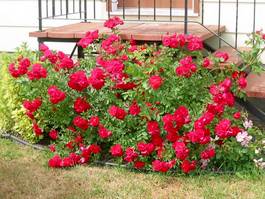
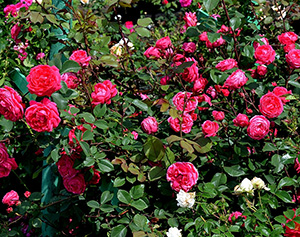
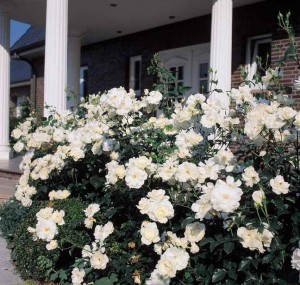

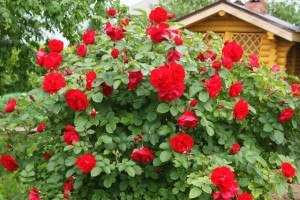

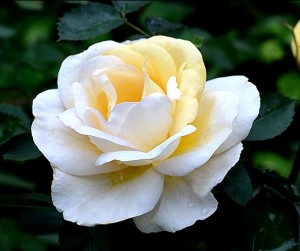



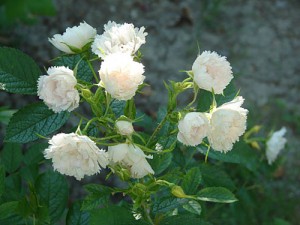

 (8 ratings, average: 4,00 out of 5)
(8 ratings, average: 4,00 out of 5) CUCUMBERS NEVER GET SICK, I'VE BEEN USING ONLY THIS FOR 40 YEARS! I SHARE A SECRET WITH YOU, CUCUMBERS ARE LIKE THE PICTURE!
CUCUMBERS NEVER GET SICK, I'VE BEEN USING ONLY THIS FOR 40 YEARS! I SHARE A SECRET WITH YOU, CUCUMBERS ARE LIKE THE PICTURE! You can dig a bucket of potatoes from each bush. Do you think these are fairy tales? Watch the video
You can dig a bucket of potatoes from each bush. Do you think these are fairy tales? Watch the video
 How our fellow gardeners work in Korea. There is a lot to learn and just fun to watch.
How our fellow gardeners work in Korea. There is a lot to learn and just fun to watch. Eye trainer. The author claims that with daily viewing, vision is restored. They don't charge money for views.
Eye trainer. The author claims that with daily viewing, vision is restored. They don't charge money for views. A 3-ingredient cake recipe in 30 minutes is better than Napoleon. Simple and very tasty.
A 3-ingredient cake recipe in 30 minutes is better than Napoleon. Simple and very tasty. Therapeutic exercises for cervical osteochondrosis. A complete set of exercises.
Therapeutic exercises for cervical osteochondrosis. A complete set of exercises. Which indoor plants match your zodiac sign?
Which indoor plants match your zodiac sign? What about them? Excursion to German dachas.
What about them? Excursion to German dachas.
I saw a hedge of rose hips. It is practically impassable, but the trouble is that this fence is constantly spreading in different directions. I would not recommend planting such a hedge; it is difficult to care for.
Informative article, thank you.
Any hedge will have to be looked after, it is alive. And a rose hedge is not the most capricious in this regard.
I have a box from D. Franklin's rose, it's completely different...